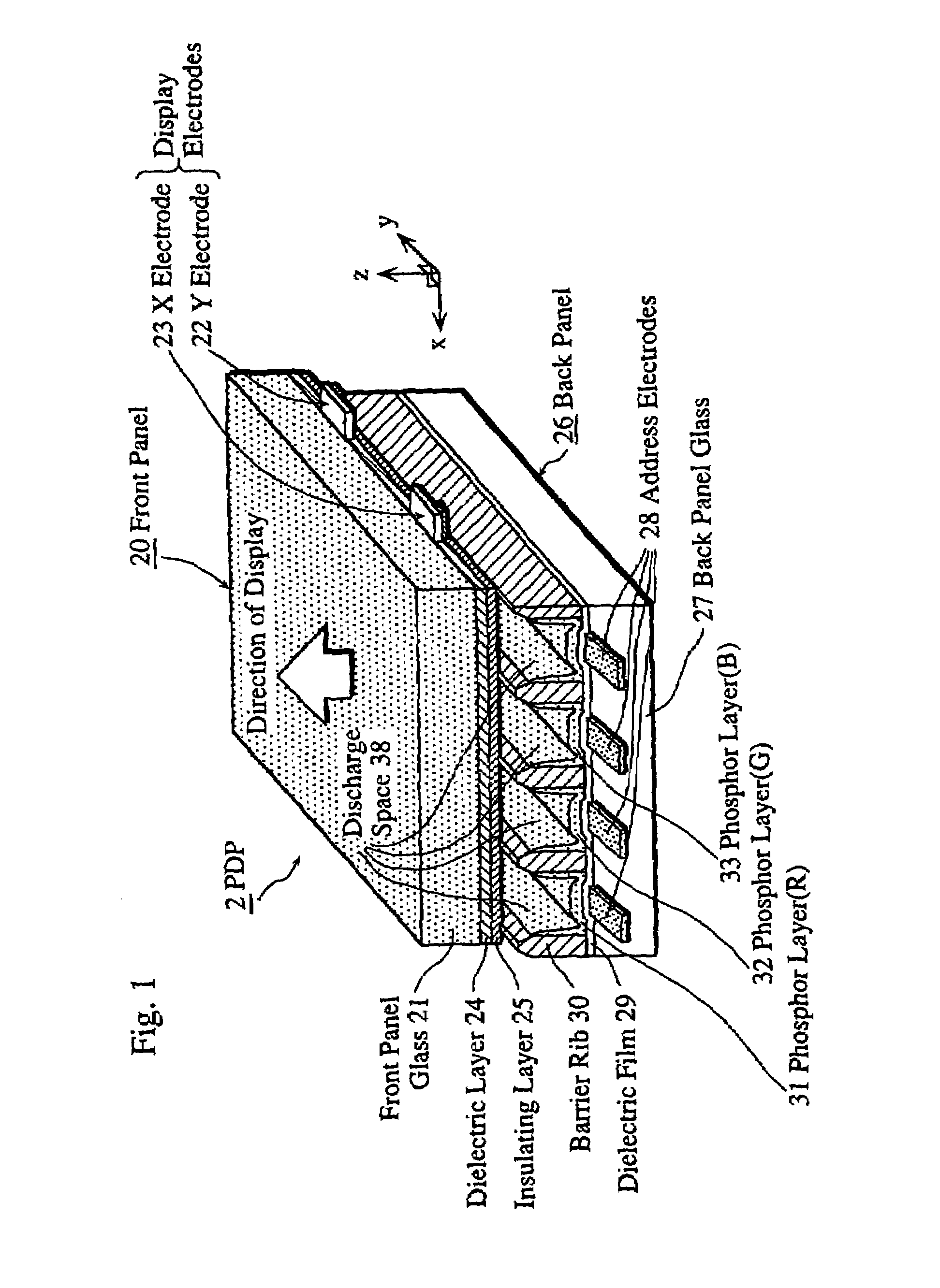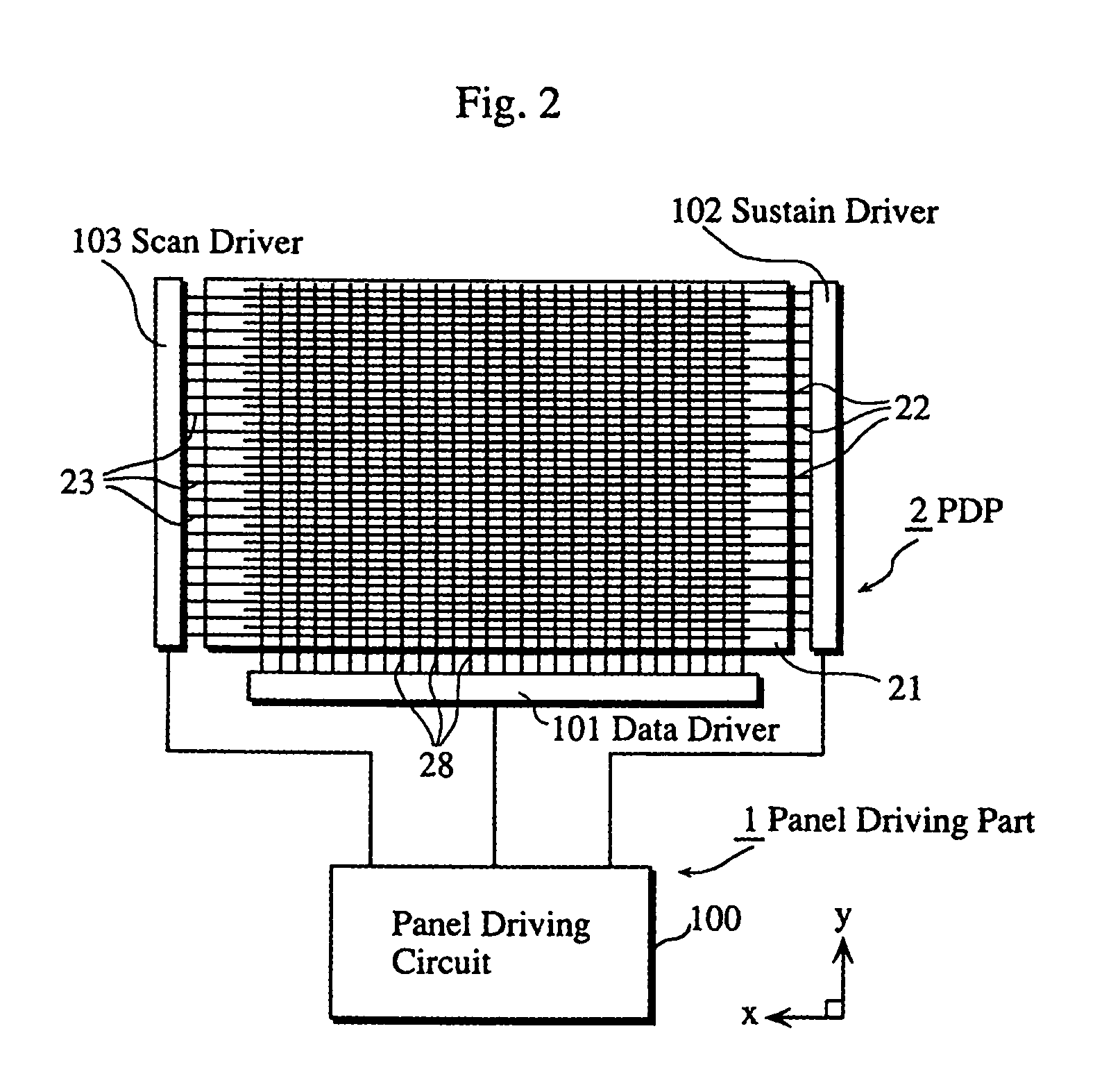Gas discharge panel with electrodes comprising protrusions, gas discharge device, and related methods of manufacture
a technology of gas discharge panel and electrode, which is applied in the manufacture of electrode systems, cold cathode, electric discharge tube/lamps, etc., can solve the problems of reducing yield rates, very involved in manufacturing processes, and inability to manufacture crts with diagonal screen sizes exceeding 40 inches, etc., to achieve excellent discharge capacity, improve illuminance efficiency, and excellent discharge capacity
- Summary
- Abstract
- Description
- Claims
- Application Information
AI Technical Summary
Benefits of technology
Problems solved by technology
Method used
Image
Examples
first embodiment
[0054]FIG. 1 is a cross-sectional perspective view showing a principal construction of an AC PDP module (hereafter “PDP 2”) of a PDP display apparatus, being an example gas discharge apparatus of the first embodiment. In FIG. 1, the PDP 2 is thick in a z direction and the surface of the PDP 2 runs parallel to the xy plane. This description applies to all the figures discussed below. The PDP display apparatus of the first embodiment is divided broadly into the PDP 2 and the panel driving part 1 described below. The construction of a panel driving part 1 is the same with respect to the first, second, and third embodiments, and to each of the variations 1-1˜1-12 and 2-1˜2-13.
[0055]As shown in FIG. 1, the PDP 2 is formed by a front panel 20 and a back panel 26 arranged so as to face each other. A front panel glass 21 forming the substrate of the front panel 20 is arranged on one side with plural pairs of display electrodes 22 and 23 (Y electrode 22, X electrode 23) running parallel in t...
second embodiment
[0093]FIG. 12 is a frontal illustration of the display electrodes of the PDP 2 of the second embodiment. FIG. 12 shows a construction having only one isolated electrode arranged on each of the bus lines 221 and 231 within each cell 340. It is, however, possible to arrange two isolated electrodes per cell, as in the first embodiment, in which case it is desirable to arrange the isolated electrodes 222 and 232 to satisfy the relation Pe=A×Ps / n.
[0094]In the second embodiment, the isolated electrodes 222 and 232 are arranged, as in the first embodiment, according to Paschen's Law, this time to have a gap (shortest gap D1) of 40 μm therebetween. As shown in FIG. 13, the squared ends of each of the inner protrusions 222a and 232a are out of alignment in the x direction. The inner protrusions 222a and 232a can be arranged, as in FIG. 12, so that central lines A and B running in the y direction are out of alignment. The “central lines” referred to here are the lines dividing the surface of ...
third embodiment
[0109]The construction of the display electrodes 22 and 23 of the third embodiment is the same as that of the first embodiment (see FIG. 4). The characteristics of the third embodiment relate mainly to the construction of the insulating layer 25. FIG. 22 is a cross-sectional view of a section of the thickness (in the z direction) of the PDP 2 of the third embodiment.
[0110]According to the construction of the PDP 2 shown in FIG. 22, an insulating layer 251 of magnesium oxide (MgO) is formed over an area corresponding to the inner protrusions 222a and 232a (i.e. the area directly above the inner protrusions 222a and 232a in FIG. 22), and an insulating layer 252 of aluminum oxide (Al2O3) is formed over the remaining area, both insulating layers 252 and 253 being formed so as to cover over the dielectric layer 24 which covers the entire surface of the front panel glass 21. The use of both magnesium oxide and aluminum oxide in the third embodiment results in the rate of electron discharg...
PUM
 Login to View More
Login to View More Abstract
Description
Claims
Application Information
 Login to View More
Login to View More - R&D
- Intellectual Property
- Life Sciences
- Materials
- Tech Scout
- Unparalleled Data Quality
- Higher Quality Content
- 60% Fewer Hallucinations
Browse by: Latest US Patents, China's latest patents, Technical Efficacy Thesaurus, Application Domain, Technology Topic, Popular Technical Reports.
© 2025 PatSnap. All rights reserved.Legal|Privacy policy|Modern Slavery Act Transparency Statement|Sitemap|About US| Contact US: help@patsnap.com



